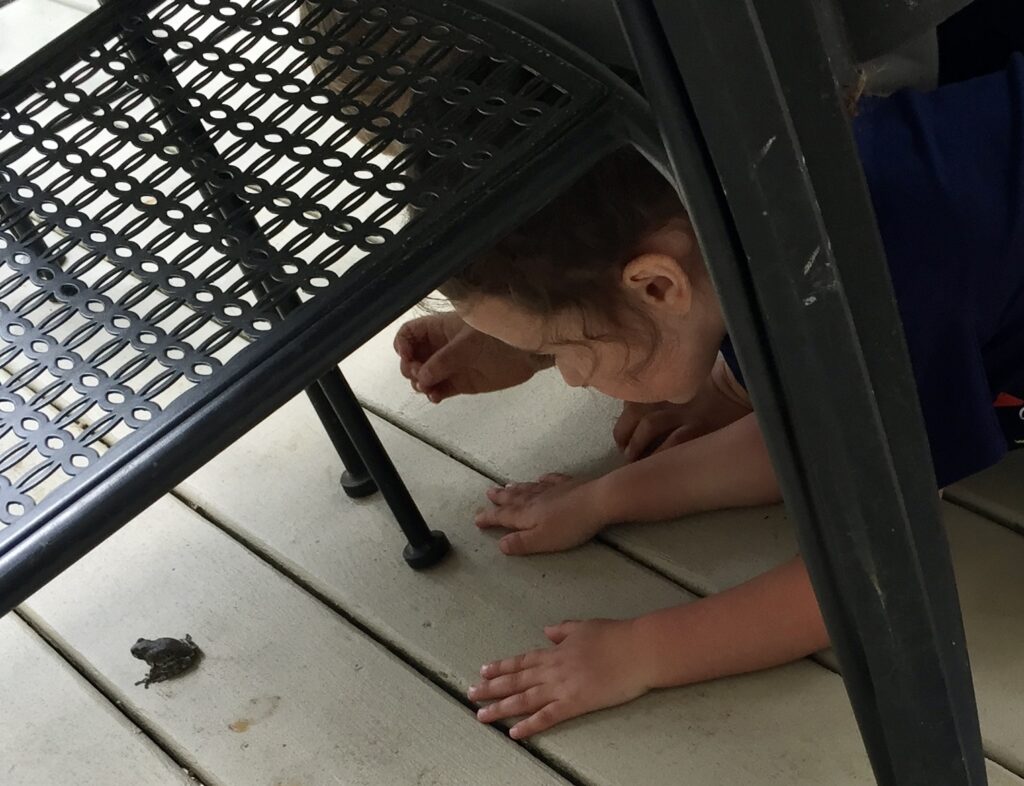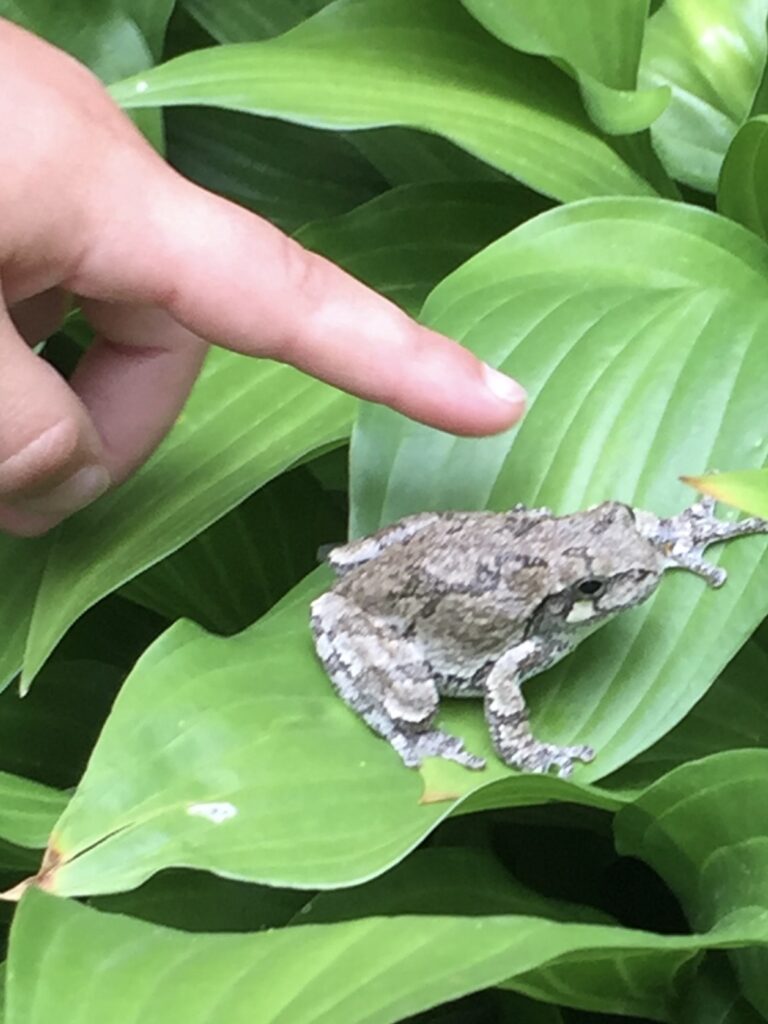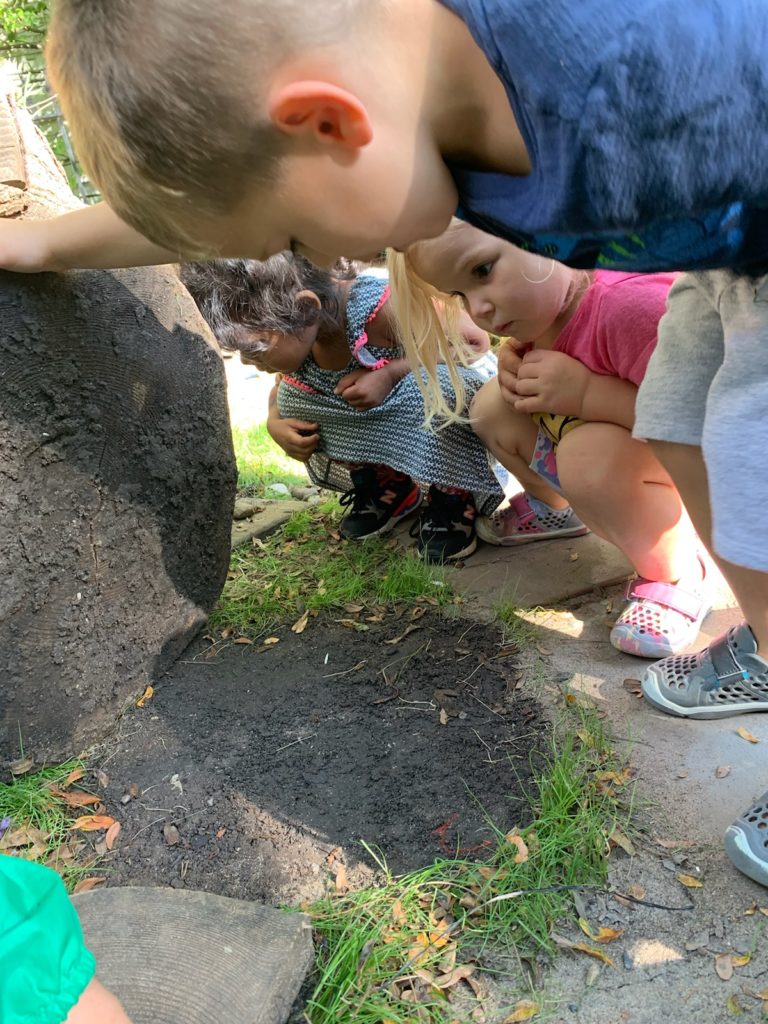Toad-Ally Awesome Science

“Get him, Avery! Get him!”
Auuughhhhh!
“Did you get him?”
“He’s over there, Rowan, get him!”
The children’s search is punctuated by high-pitched screams. Is it a snake? A grasshopper? What garden creature could be causing such a stir on a lazy Monday afternoon?
“I got him!” Rowan declares as she cradles a garden toad in her two hands.

We don’t see a lot of toads in our outdoor play space, but a wet spring has transformed our rain garden into a lush outdoor habitat that must have seemed mighty inviting to this little amphibian.
According to recent research, children prefer to have native wildlife and insects inhabiting their outdoor play spaces. That comes as no surprise to me! I am a passionate proponent of nature-based education for our youngest learners. A toad in our play space is a welcome hands-on learning opportunity that can lead to a full day of scientific investigation.
Our toad discovery came on the heels of some intentional tweaks to our play space. After observing the curiosity and wonder that worms, ladybugs and roly-polies aroused in my students, I decided to create a rain garden with native plants and pollinators, plenty of big rocks, some stumps and a few odd logs to attract more wildlife. It was a true “Field of Dreams” story: We built it and they came! The butterflies, luna moths, katydids, praying mantises and toads, that is.
If you’d like to build a rain garden of your own, see if your local or state government has a rain garden incentive program. Many municipalities have these programs to encourage residents to install rain gardens, which help manage stormwater in our sewers, reduce flooding and runoff, minimize standing water where mosquitos can breed and provide food and habitat for native wildlife. Through these programs, residents can be reimbursed for up to half the cost of the plants and compost used to build their rain gardens. We applied and were lucky enough to receive this rain garden funding.
“Did you know that a frog uses its eyes to push food down its throat when it swallows?” Rowan informs us.
“Hey wait!” chimes in Avery. “Is that a frog or a toad?”
Avery and Rowan study the toad closely.
“Look at his legs,” observes Avery. Simultaneously, the girls arrive at the answer. “It’s a toad!”

“But how do you know?” asks Monte.
“Frogs have long legs for jumping and toads have shorter legs for crawling and little hops,” Rowan answers. “But they both use their eyeballs for swallowing!”
Rowan, our budding scientist, is always full of fun facts. The weirder or grosser, the better!
“Toads can also live in drier places like the grass or our garden,” Avery adds. “Their skin is more waterproof. Frogs lose moisture a lot more easily, so they are usually found down by the water. See how this toad looks dry? A frog usually looks wet and slippery.”
How did Avery acquire this knowledge? She and her friends hang out at a creek in their neighborhood, where toad and frog learning opportunities abound.
This sharing of information is part of the beauty of child-led learning. Children who participate in active investigations to learn about their environment are engaging in the work of real scientists. They are asking questions and testing out their hypotheses to find answers. They are beginning to construct new ways of thinking by sharing their experiences with other children and interested adults.
By using their critical-thinking skills to figure out the best way to catch this small amphibian and then using their problem-solving skills to identify whether it’s a toad or a frog, they are working their way through a scientific investigation. When the children decide to build a home for the little guy, I remind them that the toad is home. This sparks another animated discussion about animal habitats!

“Well then, let’s find him some bugs to eat!” shouts Monte. The children run off to find insects while I guard their amphibious friend.
By creating gardens and play areas that are hospitable to native wildlife, we can provide plenty of opportunities for playful investigations that encourage active, hands-on learning.
Natural environments allow for investigation and discovery by children with different learning styles. These play spaces contain a hidden curriculum that is sure to arouse curiosity and wonder in every kind of learner!

When children play in natural settings, they see science in action as they learn to respect and care for the environment and its living inhabitants.
Early childhood educators can integrate nature-based learning into any established environment or curriculum to support children’s learning. Even a small corner garden in an asphalt jungle can lead to a powerful science curriculum. Add a few simple materials like plants, stumps and rocks to your outdoor area and it won’t be long before your students begin to spot bugs, insects and other living creatures.
Why not reserve 15 minutes each day for scientific field studies? As you head outdoors with your nature explorers, a “toad-ally awesome” learning opportunity may just hop into your hands!
You could also tie this into earth, air, and water by discussing what type of plants and animals need which type of earth and which type of air to thrive.
This is great for teaching children about habitats along with earth, water and air
We have lots of toads at our center and the ideas in this article are so much fun to carry out with the kids. They love learning about the toads that they see here.
These are great ideas for an early childhood classroom. Kids love to learn about the living things they can actually see and touch,
We are definitely doing this!
love it